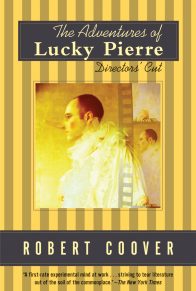I was in the rocking chair giving our six-month-old Bug her late afternoon bottle. Patty was at work. I had pulled the windowshades halfway down: sunlight turned their stiff fabric the luminous deep-fat-fried color of a glazed doughnut. Still visible from a year earlier was the faint outline in adhesive of one of the lengths of masking tape that we had Xed excitedly over the windowpanes before a hurricane that hadn’t panned out; below it, a metal tube of antifungal ointment lay on the sill, its wrinkled tail spiraled back like a scorpion’s, its Scotch-taped pharmaceutical torso of typed information so bathed in light now that I could make out only the normally pedestrian but now freshly exotic name of the prescribing pediatrician, “Dr. Momtaz.”
The shade-pulls, rings wound apparently with common kite string, lunetted pieces of the distant horizon for further study: a section of a water tower, a brilliant white sweat sock of steam that was slowly emerging from one of three smokestacks across the water somewhere in Charlestown, and a rotating bun-shaped air vent on the top of a twelve-story old-folks home in North Quincy, whose dents and irregularities sent corpuscles of pewtery dazzlement in my direction. Half a mile away, some dark birds, not gulls or crows I don’t think, were on their way toward Boston. Their flight reminded me strongly of something, and as they flapped slowly from the sky under one windowshade to the sky under the next, I realized that the movement of their wings as they turned this way and that, negotiating big chunks of wind, was remarkably similar to the flapping of a small dog’s ears as it ran at full speed in excited zigzags across a field. I was extremely pleased that the sight of several silent far-off birds could remind me of the yapping frolic-someness of a puppy—it seemed a tricky lateral sort of comparison, in which the two terms threaten to be insufficiently disparate in some respects for the connection to work properly, as if you said that the sun was in some way or other like the moon. Other birds, much farther away, rested stilly against the haze like flakes of ground pepper. The whole outside, in fact, what I could see of it, looked unusually good and deserving of similes today—cleaner, sharper, more richly colored: I had removed the screens from the windows the day before, because the hot weather seemed to be gone for the year.
Also as a result of the weather, I was wearing a sweater for the first time in months, one Patty had given me for my birthday: a brown monster stout with various fugal inversions and augmentations of the standard cable knit, and consequently glutted with insulational dead air, its corona of lighter outer fibers frizzing out three-eighths of an inch or more from the slubbed and satisfyingly clutchable weave that formed the actual structure underneath, so that the sweater, along with me, its wearer, appeared to fade without a demonstrable outer boundary into the rest of the room, as tuning forks or rubber bands will seem in their blurred vibration to transform their material selves into the invisible sound they generate; a machine-made sweater, but manufactured apparently with Xenakian lurches and indecisions programmed into the numerically controlled needles that, unlike the chain flayings and bleaching stains used in production lines to antique new furniture, gave it to my eye an attraction distinct from the irregular grandmotherly alternations between close attention and indignant abandonment at historical preservation meetings prominent in handmade knitwear. Patty had ordered it for me from a catalog; when I shifted my weight slightly in the rocker, the sweater’s mute woolly bulk made me feel particularly fatherly and head-of-householdish—though in fact it was Patty, working three days a week at an advertising firm to my two as a technical writer for a medical imaging company, who got us health insurance. I was pleased to see how comfortable the Bug looked with her head in the crook of my arm, unaware through the loft of all that yarn of my elbow tendon tautly supporting her.
Like a screech trumpet player, she held her bottle with one hand; her other hand roved in search of textures: my sweater’s, of course, but also a wrinkle and the nipply bump of a snap on her own striped outfit, her hair and ear, and especially the raised ounce and cubic-centimeter demarcations that were molded into her Evenflo bottle’s plastic, like the fractions of a cup that had once been molded into glass peanut butter jars, so useful for practicing your fingertip-reading skills on while you ate. The raised outlines of the peanut butter jars’ ”1/3”s and ”¾”s would act, I recalled, as lenses, focusing light, projecting secondary cashmere images (not shadows) of themselves through the thickness of glass and onto the browner inner cylinder of the peanut butter, images that were often easier to read than the molded markings themselves, which were only partially defined by highlights. My mother told my sister and me that when she was breastfeeding us she ate peanut butter straight from the jar with a tablespoon, and perhaps because of her own maternal craving she didn’t mind later when I took a full jar and a silver spoon upstairs with me while building my plastic models. (I “chopped” models by gluing out-of-scale chrome-plated halves of engine blocks and exhaust systems from funny cars and dragsters onto the wings of warplanes.) The taste of the peanut butter was sharp enough to make my eyes water, and the glottally claustrophobic sense of being repeatedly on the verge of choking on several overlarge gouges was appealingly risky, although I sometimes preferred rather to work a single spoonful down very slowly, setting it aside on the newspaper for a moment when I needed two hands (in order, for example, to detach one half of a ram-air induction scoop from the molded parking-lot grid of engine components to which it was linked by twisting it back and forth until the plastic finally whitened and gave way); each time I withdrew the spoonful from my mouth, my upper lip left a freshly aerodynamic shape on it that sharpened my already fierce appreciation of the plane’s swept-back airfoils and cockpit canopy. And when I had finished hybridizing the model—when the last McPherson strut was glued prominently to the side of a jet nacelle, where its ornamental usefulness was not lost, as it was when hidden in the uninteresting stock car’s body whose components I was using—the remnant of peanut butter in the back of my mouth allowed me to simulate more convincingly the fricative roar of a ribcrushingly tight turn on the test flight above the Golden Encyclopedia; and this in turn contributed to my sense of the fitness of the name Skippy: k sounds came very naturally to the mouth during and after a major spoonful. And then, eighteen or so years later, not long after Patty’s urine pinkened conclusively in the plastic vial, she asked me if I could maybe pick up a small jar of peanut butter on my way home from work. Absolutely! Before that day, I had never heard her express even a mild interest in peanut butter. I’d stopped eating it myself. I jabbed a tablespoon vertically into the new six-ounce jar I had chosen for her and left the arrangement in the middle of the kitchen table for her to find when she got out of her shower; and then I thought better of this over-preparation and pulled the spoon out and smoothed out its C-shaped intrusion and tightened the lid again so that she might think that the seal had never been broken, because she might want (as I certainly had wanted years before) the pleasure of being the first to dig into the lunar surface herself. She probably would want to use a knife and make a sandwich anyway, I thought. I put the spoon in the sink. But half an hour later I found her flipping through an in-flight magazine with the jar open on the arm of the couch and a teaspoon upside down in her mouth. Tears came to my eyes. “Straight from the jar, baby!” I said. Soon she had a stomach profile as smoothly Bernoullian as my model-building Skippy spoonfuls, and I, perhaps influenced by that anecdote in Shakespeare about the votaress who got pregnant and grew, like a sail, “big-bellied with the wanton wind,” began to visualize her lying with her legs strapped down in a wind tunnel wearing a shiny leotard, giving teasing effleurage to her dome, calling for a technician to apply some Chap Stick to her lips from time to time, while I, a promising young engineer at work on the next generation of airbus wings, evaluated the inexplicable magnitude of lift her Bug-mound aroused in the moaning tunnel’s air by pumping luminous gases through the smoke rake and watching their streaklines veer upward and interlace, laminarity disrupted by the brief fuss of her pubic hair, shedding into elaborate lasso shapes and beehives of induced flow that after only a few minutes of flight-speed wind made the entire research installation knock and shiver with worrisome resonances.













